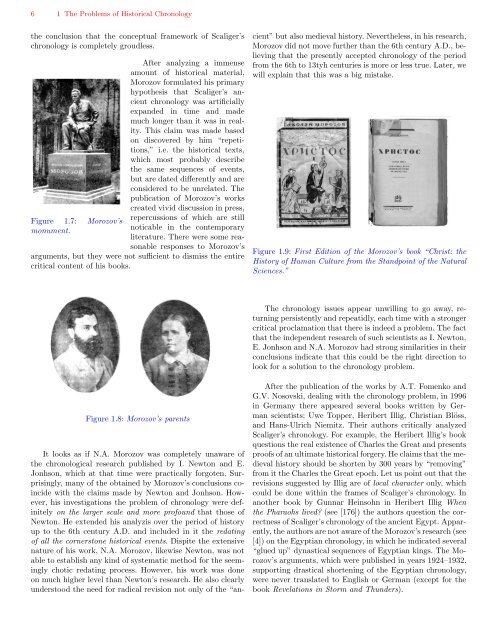mysteries of egyptian zodiacs - HiddenMysteries Information Central
mysteries of egyptian zodiacs - HiddenMysteries Information Central
mysteries of egyptian zodiacs - HiddenMysteries Information Central
Create successful ePaper yourself
Turn your PDF publications into a flip-book with our unique Google optimized e-Paper software.
6 1 The Problems <strong>of</strong> Historical Chronology<br />
the conclusion that the conceptual framework <strong>of</strong> Scaliger’s<br />
chronology is completely groudless.<br />
Figure 1.7: Morozov’s<br />
monument.<br />
After analyzing a immense<br />
amount <strong>of</strong> historical material,<br />
Morozov formulated his primary<br />
hypothesis that Scaliger’s ancient<br />
chronology was artificially<br />
expanded in time and made<br />
much longer than it was in reality.<br />
This claim was made based<br />
on discovered by him “repetitions,”<br />
i.e. the historical texts,<br />
which most probably describe<br />
the same sequences <strong>of</strong> events,<br />
but are dated differently and are<br />
considered to be unrelated. The<br />
publication <strong>of</strong> Morozov’s works<br />
created vivid discussion in press,<br />
repercussions <strong>of</strong> which are still<br />
noticable in the contemporary<br />
literature. There were some reasonable<br />
responses to Morozov’s<br />
arguments, but they were not sufficient to dismiss the entire<br />
critical content <strong>of</strong> his books.<br />
Figure 1.8: Morozov’s parents<br />
It looks as if N.A. Morozov was completely unaware <strong>of</strong><br />
the chronological research published by I. Newton and E.<br />
Jonhson, which at that time were practically forgoten. Surprisingly,<br />
many <strong>of</strong> the obtained by Morozov’s conclusions coincide<br />
with the claims made by Newton and Jonhson. However,<br />
his investigations the problem <strong>of</strong> chronology were definitely<br />
on the larger scale and more pr<strong>of</strong>ound that those <strong>of</strong><br />
Newton. He extended his analyzis over the period <strong>of</strong> history<br />
up to the 6th century A.D. and included in it the redating<br />
<strong>of</strong> all the cornerstone historical events. Dispite the extensive<br />
nature <strong>of</strong> his work, N.A. Morozov, likewise Newton, was not<br />
able to establish any kind <strong>of</strong> systematic method for the seemingly<br />
chotic redating process. However, his work was done<br />
on much higher level than Newton’s research. He also clearly<br />
understood the need for radical revision not only <strong>of</strong> the “an-<br />
cient” but also medieval history. Nevertheless, in his research,<br />
Morozov did not move further than the 6th century A.D., believing<br />
that the presently accepted chronology <strong>of</strong> the period<br />
from the 6th to 13tyh centuries is more or less true. Later, we<br />
will explain that this was a big mistake.<br />
Figure 1.9: First Edition <strong>of</strong> the Morozov’s book “Christ: the<br />
History <strong>of</strong> Human Culture from the Standpoint <strong>of</strong> the Natural<br />
Sciences.”<br />
The chronology issues appear unwilling to go away, returning<br />
persistently and repeatidly, each time with a stronger<br />
critical proclamation that there is indeed a problem. The fact<br />
that the independent research <strong>of</strong> such scientists as I. Newton,<br />
E. Jonhson and N.A. Morozov had strong similarities in their<br />
conclusions indicate that this could be the right direction to<br />
look for a solution to the chronology problem.<br />
After the publication <strong>of</strong> the works by A.T. Fomenko and<br />
G.V. Nosovski, dealing with the chronology problem, in 1996<br />
in Germany there appeared several books written by German<br />
scientists; Uwe Topper, Heribert Illig, Christian Blöss,<br />
and Hans-Ulrich Niemitz. Their authors critically analyzed<br />
Scaliger’s chronology. For example, the Heribert Illig’s book<br />
questions the real existence <strong>of</strong> Charles the Great and presents<br />
pro<strong>of</strong>s <strong>of</strong> an ultimate historical forgery. He claims that the medieval<br />
history should be shorten by 300 years by “removing”<br />
from it the Charles the Great epoch. Let us point out that the<br />
revisions suggested by Illig are <strong>of</strong> local character only, which<br />
could be done within the frames <strong>of</strong> Scaliger’s chronology. In<br />
another book by Gunnar Heinsohn in Heribert Illig When<br />
the Pharaohs lived? (see [176]) the authors question the correctness<br />
<strong>of</strong> Scaliger’s chronology <strong>of</strong> the ancient Egypt. Apparently,<br />
the authors are not aware <strong>of</strong> the Morozov’s research (see<br />
[4]) on the Egyptian chronology, in which he indicated several<br />
“glued up” dynastical sequences <strong>of</strong> Egyptian kings. The Morozov’s<br />
arguments, which were published in years 1924–1932,<br />
supporting drastical shortening <strong>of</strong> the Egyptian chronology,<br />
were never translated to English or German (except for the<br />
book Revelations in Storm and Thunders).



